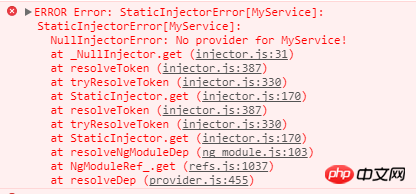这次给大家带来在Angular里ViewProviders和Providers的区别,在Angular里使用ViewProviders和Providers的注意事项有哪些,下面就是实战案例,一起来看一下。
在Angular中使用依赖注入(DI)的时候,我们一般会使用providers。其实要做同样的事我们还有另外一个选择:viewProviders。
viewProviders允许我们定义只对组件的view可见的provider。下面我们用例子详细的说明这一点。
假设我们有一个简单的服务:
// myService.service.ts
import { Injectable } from '@angular/core';
@Injectable()
export class MyService{
testIfGetService(where){
console.log('Got My Service in ' + where);
}
}这个服务很简单,只需要打印出在哪里调用了该服务。
然后有一个子组件,是用来投射到父组件里面的(等会将会看到):
// child.component.ts
import { Component } from '@angular/core';
import { MyService } from './myService.service';
@Component({
selector: 'vp-child',
template: `
<p>this is child!!!</p>
`
})
export class VPChild{
constructor(
private service: MyService
){
this.service.testIfGetService('child');
}
}这个组件注入了MyService服务,调用MyService的testIfGetService方法,并传入child表明这是在child组件调用的。
还有另外一个子组件,这个组件是用来放在父组件的模板(template)里面的:
// viewChild.component.ts
import { Component } from '@angular/core';
import { MyService } from './myService.service';
@Component({
selector: 'vp-viewchild',
template: `
<p>This is viewChild!!!</p>
`
})
export class ViewVPChild{
constructor(
private service: MyService
){
this.service.testIfGetService('viewChild');
}
}这里同样注入MyService服务,调用MyService服务的testIfGetService方法,并传入viewChild。
最后是父组件:
// parent.component.ts
import { Component } from '@angular/core';
import { MyService } from './myService.service';
@Component({
selector: 'vp-parent',
template: `
<p>This is parent!!!</p>
<ng-content></ng-content>
<vp-viewchild></vp-viewchild>
`,
providers: [MyService]
})
export class VPParent{
constructor(
private service: MyService
){
this.service.testIfGetService('parent');
}
}在父组件,用providers注册MyService,然后调用MyService的testIfGetService传入parent。
然后就像这样使用父组件:
<vp-parent> <vp-child></vp-child> </vp-parent>
运行程序,控制台打印出了结果:
一切就像预期那样!!
然后,我们用viewProviders代替providers注册MyService,看看会发生什么:
// parent.component.ts
import { Component } from '@angular/core';
import { MyService } from './myService.service';
@Component({
selector: 'vp-parent',
template: `
<p>This is parent!!!</p>
<ng-content></ng-content>
<vp-viewchild></vp-viewchild>
`,
viewProviders: [MyService] // <---
})
export class VPParent{
constructor(
private service: MyService
){
this.service.testIfGetService('parent');
}
}这样修改之后,运行程序,发现报错了:
如果把contentChild注释掉,就像这样:
<vp-parent> <!-- <vp-child></vp-child> --> </vp-parent>
是不会报错的:
这就说明,在父组件用viewProviders注册的provider,对contentChildren是不可见的。而使用providers注册的provider,对viewChildren和contentChildren都可见!
补充说明:组件会逐级向上寻找provider,直到找到为止,否则就会抛出错误。就像这里:
<vp-parent> <vp-child></vp-child> </vp-parent>
vp-child往上找MyService的provider,结果在vp-parent找到了。但是在用viewProviders的时候,vp-child往上找,也就是到vp-parent,结果没找到,然后又去找vp-parent的父级,还是没找到(因为在这个例子里,我们只在vp-parent注册了MyService),然后又继续往上找……如此找到边界也没找到,所以抛出了一个错误。如果你不希望这样,可以使用@Host做出限制,就像这样:
constructor(
@Host() private service: MyService
){}关于@Host()本文不作展开,有兴趣可以自行google。
相信看了本文案例你已经掌握了方法,更多精彩请关注php中文网其它相关文章!

2013年07月06日 V1.60 升级包更新方式:admin文件夹改成你后台目录名,然后补丁包里的所有文件覆盖进去。1.[新增]后台引导页加入非IE浏览器提示,后台部分功能在非IE浏览器下可能没法使用2.[改进]淘客商品管理 首页 列表页 内容页 的下拉项加入颜色来区别不同项3.[改进]后台新增/修改淘客商品,增加淘宝字样的图标和天猫字样图标改成天猫logo图标4.[改进]为统一名称,“分类”改
 0
0

推荐阅读:
以上就是在Angular里ViewProviders和Providers的区别的详细内容,更多请关注php中文网其它相关文章!

每个人都需要一台速度更快、更稳定的 PC。随着时间的推移,垃圾文件、旧注册表数据和不必要的后台进程会占用资源并降低性能。幸运的是,许多工具可以让 Windows 保持平稳运行。

Copyright 2014-2025 https://www.php.cn/ All Rights Reserved | php.cn | 湘ICP备2023035733号